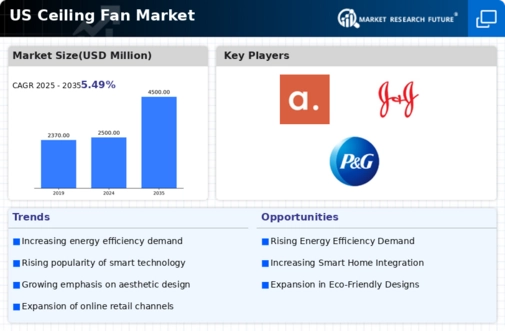Shift Towards Sustainable Living
A significant shift towards sustainable living is influencing the ceiling fan market. Consumers are increasingly prioritizing products that align with their values regarding environmental responsibility. This trend is reflected in the rising popularity of ceiling fans made from sustainable materials and those designed for energy efficiency. The U.S. Environmental Protection Agency has noted a growing consumer preference for eco-friendly products, which is expected to continue. As a result, manufacturers are adapting their offerings to include sustainable options, thereby appealing to a broader audience. This focus on sustainability is likely to enhance the competitive landscape of the ceiling fan market.
Increased Home Renovation Activities
The ceiling fan market is benefiting from a surge in home renovation activities across the U.S. As homeowners invest in upgrading their living spaces, ceiling fans are often prioritized for their aesthetic and functional benefits. The National Association of Home Builders reports that home improvement spending is expected to rise by 10% in the coming year. This trend is particularly evident in urban areas, where space optimization is crucial. Ceiling fans not only enhance air circulation but also serve as stylish fixtures that complement modern interior designs. Consequently, this growing interest in home renovations is likely to drive sales in the ceiling fan market.
Technological Advancements in Fan Design
Technological advancements are reshaping the ceiling fan market, with innovations enhancing performance and user experience. Modern ceiling fans now incorporate features such as remote controls, smart home integration, and variable speed settings. These advancements cater to the growing consumer preference for convenience and customization. According to industry reports, the integration of smart technology in ceiling fans is projected to grow by over 25% annually. This shift not only improves energy efficiency but also aligns with the increasing demand for connected home devices. As a result, manufacturers are investing in research and development to create cutting-edge designs that appeal to tech-savvy consumers in the ceiling fan market.
Rising Demand for Energy-Efficient Solutions
The ceiling fan market is experiencing an increase in demand for energy-efficient solutions. As consumers become more environmentally conscious, they seek products that reduce energy consumption. Ceiling fans, which can lower air conditioning costs by up to 40%, are increasingly favored. The U.S. Department of Energy indicates that energy-efficient ceiling fans can significantly decrease electricity bills, making them an attractive option for homeowners. This trend is further supported by various state and federal incentives promoting energy-efficient appliances. Consequently, manufacturers are focusing on developing models that meet or exceed Energy Star ratings, thereby enhancing their appeal in the ceiling fan market.
Expansion of Retail Channels and Online Sales
The ceiling fan market is seeing an expansion of retail channels, particularly with the growth of online sales platforms. E-commerce has transformed how consumers shop for ceiling fans, providing them with access to a wider variety of products and competitive pricing. According to recent data, online sales in the home improvement sector have increased by over 30% in the past year. This shift allows consumers to compare features and prices easily, leading to informed purchasing decisions. Retailers are also enhancing their online presence, offering virtual consultations and augmented reality tools to visualize products in homes. This evolution in retail strategy is likely to bolster the ceiling fan market.














Leave a Comment